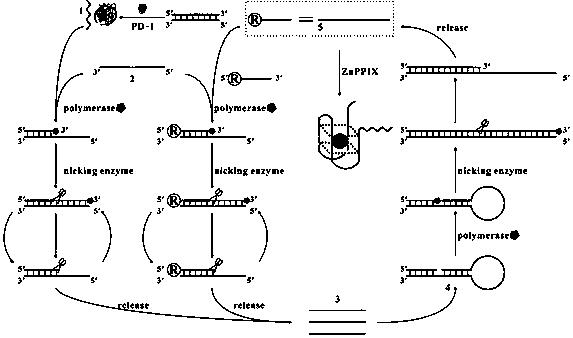Method for carrying out cyclic polymerization label-free fluorescence detection on PD-1 (Programmed Cell Death-1) based on nucleic acid aptamer
A nucleic acid aptamer, PD-1 technology, applied in the field of analytical chemistry and biosensing detection, to achieve the effect of high actual sample detection capability, high sensitivity and selectivity, and high sensitivity detection
- Summary
- Abstract
- Description
- Claims
- Application Information
AI Technical Summary
Problems solved by technology
Method used
Image
Examples
Embodiment 1
[0025] Example 1: Establishment of a method for label-free detection of PD-1 based on nucleic acid aptamer-based cyclic polymerization
[0026] 1. Reaction time optimization for cyclic polymerization
[0027] The fluorescence signal intensity corresponding to different reaction times after adding hairpin DNA4 was systematically investigated. The results show that within 2 to 5 hours, the fluorescent signal becomes stronger with the increase of the cyclic polymerization reaction time. When the reaction time is 6 hours, the signal is almost the same as that of 5 hours. Therefore, we choose the cyclic polymerization reaction time in the experiment for 5 hours.
[0028] 2. Fluorescence sensor sensitivity
[0029] Different concentrations of PD-1 were added to the reaction system, and the results showed that the fluorescence intensity was the strongest at the excitation wavelength of 416 nm and the emission wavelength of 590. The fluorescence intensity of the reaction system inc...
Embodiment 2
[0032] Example 2: Detection of PD-1 in serum
[0033] Take 1mL of rat serum, and then detect according to the optimized conditions, PD-1 was not detected. Another rat serum was taken, and PD-1 standard substances of different concentrations were added to the serum, and then the detection was carried out according to the optimized conditions. The results showed that PD-1 could be detected, and the recovery rate was between 89.6% and 104.3%. It shows that the method has good specificity and specificity, and can be used for the detection of biological samples such as serum containing PD-1.
PUM
 Login to View More
Login to View More Abstract
Description
Claims
Application Information
 Login to View More
Login to View More - R&D
- Intellectual Property
- Life Sciences
- Materials
- Tech Scout
- Unparalleled Data Quality
- Higher Quality Content
- 60% Fewer Hallucinations
Browse by: Latest US Patents, China's latest patents, Technical Efficacy Thesaurus, Application Domain, Technology Topic, Popular Technical Reports.
© 2025 PatSnap. All rights reserved.Legal|Privacy policy|Modern Slavery Act Transparency Statement|Sitemap|About US| Contact US: help@patsnap.com


